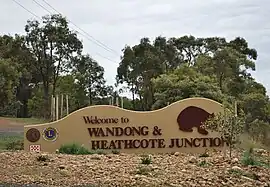Wandong
Wandong /ˈwɒndɒŋ/ is a town in Victoria, Australia. The town is about 50 kilometres (30 mi) north of the state capital, Melbourne, on the Hume Highway. It adjoins the town of Heathcote Junction, and at the 2016 census, the two towns had a population of 1,340.[1] The main centre nearest Wandong is Kilmore.
| Wandong Victoria | |||||||||||||||
|---|---|---|---|---|---|---|---|---|---|---|---|---|---|---|---|
 Entry sign | |||||||||||||||
 Wandong | |||||||||||||||
| Coordinates | 37°21′S 145°01′E | ||||||||||||||
| Population | 1,340 (2016 census)[1] | ||||||||||||||
| Postcode(s) | 3758 | ||||||||||||||
| Elevation | 307 m (1,007 ft) | ||||||||||||||
| Location |
| ||||||||||||||
| LGA(s) | Shire of Mitchell | ||||||||||||||
| State electorate(s) | Euroa and Yan Yean | ||||||||||||||
| Federal division(s) | McEwen | ||||||||||||||
| |||||||||||||||
History
The traditional owners of Wandong are the Taungurung people, a part of the Kulin nation that inhabited a large portion of central Victoria including Port Phillip Bay and its surrounds.[2] Wandong itself is an Aboriginal word meaning "Spirit".[3]
The first Europeans to reach Wandong were Hamilton Hume and Captain William Hilton Hovell who travelled through the centre of the future town of Wandong on the 13th December, 1824. The explorers proceeded 1260 metres South of Arkell’s Lane, Wandong and crossed the Dividing Range at the low peak there that they named Hume’s Pass. They then moved South along Eastern Ridge, Hidden Valley, and downhill to the Merri Creek, Wallan East near Kelby Lane.
That made Wandong the second township site in Victorian history to be traversed by European explorers. Broadford was the first: Hume and Hovell had passed through it on the same morning.
This exact route has been proven by decoding the map drawn by Hamilton Hume which conforms exactly to the original journal of William Hovell.[4] Hamilton Hume in 1867 corrected his own earlier error that the party crossed the Dividing Range at Big Hill, Bylands.[5]
Wandong was a pastoral region from at least 1843.[6]
By 1876 a small settlement had arisen and a post office gazetted to Mr. F. G. Arkell.[7]
From 1880 Wandong became a major sawmilling and processing town and region.[8]
The town is now a major transport hub with the Hume Highway and the Albury-Wodonga and Shepparton railway lines passing through it. It has its own railway station.
The local school was originally situated to the south of Wandong/Heathcote Junction and was known as Lightwood Flat Common School when it opened in 1871.[9] The school was transferred to its current site in Wandong in 1882, and is currently known as Wandong Primary School.[9] The school was damaged slightly in the Black Saturday bushfires.[9]
The town hosts the Wandong Country Music Festival.
References
- "2016 Census QuickStats Wandong". Australian Bureau of Statistics. Retrieved 3 August 2019.
- Clark, Ian D. Aboriginal languages and clans: an historical atlas of western and central Victoria, 1800-1900, Dept. of Geography and Environmental Science, Monash University, Melbourne, 1990, p363.
- Mission to the Aborigines, Sydney Herald, 7 July 1836, p. 2.
- Williams, Martin. Hamilton Hume Sketch Maps: Origins and Modern Treatment, Victorian Historical Journal, Vol. 92, No. 1, June 2021, p. 21
- Letter from Hamilton Hume to William Westgarth, 12 June 1867, Ah 12/5, Hamilton Hume correspondence, 1810–1867, with associated papers, 1910-1919, SLNSW.
- Pickett, Ron, Ghosts, Gold and a White Elephant, Wandong/Heathcote Junction Community Group Inc. 2011. p. 11.
- F. G. Arkell, Wandong, Kilmore Free Press, 26 October, 1876, p. 2
- Pickett, Ron, Ghosts, Gold and a White Elephant, Wandong/Heathcote Junction Community Group Inc. 2011. p. 16.
- "Wandong Primary School". Retrieved 24 March 2021.
External links
![]() Media related to Wandong, Victoria at Wikimedia Commons
Media related to Wandong, Victoria at Wikimedia Commons